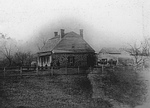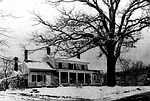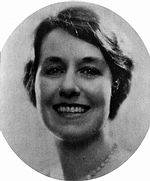Closter Road, Part I
This section of Closter Road, winding gently downhill from the corner by the Palisades Library to the New Jersey state line, has a long and fascinating history. It is one of the oldest roads in Palisades, having been laid out in 1745 over an earlier track that connected the tiny community here with the more thickly settled areas in northern Bergen County.
A map made in 1780 shows three houses, all now vanished: Woolsey (Willsey), Gesner and that belonging to Jacob Post, who bought a 90 acre farm here in 1765. Another Willsey house, now lived in by Bill Saum and Laurie Ferguson, may have been built in the 18th century, and the Nicholas Gesner house at the end of the road, now lived in by Herb and Jeannette Kellogg, was built in 1793. For many years Nicholas Gesner kept a diary that recorded life in Palisades at the time; the Palisades Library has a copy.
An 1874 map of Palisades shows only a dozen houses on the road. There were two blacksmith shops and a bakery at the north end, two Post houses (one pictured on the next page) in the middle, and a cluster of older houses near the south end. One of them was a tavern where drivers of 19th century ox-teams would stop to wet their whistles. Bill Knudson has lived on Closter Road since 1921, when he and his mother moved back to Palisades with his grandparents, William and Babette Blanken. Ninety years later Bill is still living in the house his grandfather bought. He remembers some differences between long ago times and Palisades today. Neighbors knew each other better than they do now, and there were fewer houses and fewer trees. You could see the houses on Oak Tree Road clearly from Closter Road. Across the street from his house was the Salma dairy with a big pasture behind filled with cows. Because so much of the land was cleared, many animals we are used to seeing today were uncommon. Deer were never seen.
A dozen new houses were built in the 1920s and 30s, but the road didn’t change much. Herb Kellogg, who moved to the old Gesner house with his wife Jeanette in 1947, describes Palisades at that time as being “very sleepy, very quiet. People hadn’t gotten around to painting their houses; there were very few gardens, very little traffic, very little noise.”
In 1953 the Palisades Free Library moved into the old Jordan house at the corner; the Jordans had been florists with greenhouses on Oak Tree Road.
Albon Man, who moved to Closter Road in 1955, reminisced with me about some of the road’s former residents, larger-than-life-size people who played an important part in the history of Palisades. The area which is now Post Lane belonged at the time to Harry Schaffer, who gardened for himself and also worked for other people. Turkey shoots were held on the property every year at Thanksgiving and Christmas. Soon after the Mans moved in, Albon’s wife Yolanda suggested that he attend the turkey shoot where he might meet some neighbors. Although Albon didn’t own a gun, on his arrival he was handed a shotgun and urged to try his luck. Apparently everyone else participating in this round had been too drunk to hit the target. Albon was surprised to find that he was a winner, bringing home a voucher entitling him to a free turkey from Boss’s Meat Market.
After Harry Schaffer’s death, the property was sold to Dr. Schaff, a veterinarian who stocked the property with horses, chickens, pheasants and peacocks. He also provided the biggest scandal Closter Road ever had when in 1967 he shot and killed his girlfriend’s lover and went off to spend several years in jail. Later the property was sold to the developer who created Post Lane.
Albon was friendly with the prize-winning and somewhat unworldly poets Horace and Marya Gregory who lived at 83 Closter Road. Horace had a brilliant mind but was physically handicapped. Marya, after picking up the Gregory mail at the post office, would often open it on the way home, throwing the letters that contained bills to the side of the road.
Kathleen and Everett Martine, who lived at 143 Closter Road, were another remarkable couple. Kathleen was a talented pianist and had played for NBC radio in her twenties. For many years she was choir mistress of the Palisades Presbyterian Church and was also known for her beautiful garden. Albon describes Everett as “a formidable character, the uncrowned mayor of Closter Road.”
Everett was fiercely conservative, as were two other memorable residents of the road, Laura Ebmeyer and Arthur Stansbury. Laura Ebmeyer, Palisades postmistress from 1955 to 1989, lived at 18 Closter Road. She was responsible for the building of our current post office in 1962 and organized a Senior Citizen’s Cub at the Community Center during the 1980s. Archer Stansbury, always on the lookout for ungodly thinking, once told Albon that Columbia University was a hotbed of radicals. His wife Helene was very active in the preservation of the Palisades Cemetery; they lived at 50 Closter Road.
A few more houses were added to Closter Road in the second half of the twentieth century. It also began to grow branches. Sometime in the 1940s Chipman Lane was created, adding several new houses, including the Vezzetti house. Indian Hill Lane was started in 1951. In 1958 the Palisades Parkway was completed, destroying an 18th century Willsey house. In 1966 Joanne Bergman acquired twelve acres on Closter Road and subdivided them to create a small development, Century Road. Closter Woods, a collection of houses built on Post Lane, was completed in 1986. Fern Road, on the east side of Closter Road, was also completed during this decade.
Albon, asked what changes he has observed over the years, commented that there are fewer families with children living on the road, and that perhaps people are less likely to know their neighbors. One of his stories illustrates these changes. It was a snowy Christmas Eve in the 1960s and his children’s Christmas presents, mailed days before, had not yet arrived. Delivery had been held up by bad weather. Night fell, and Albon and his wife resigned themselves to face their disappointed offspring in the morning. At midnight someone knocked loudly on the front door. It was Ed Ebmeyer, the husband of the postmistress, delivering the presents that had just arrived by a very late mail.




